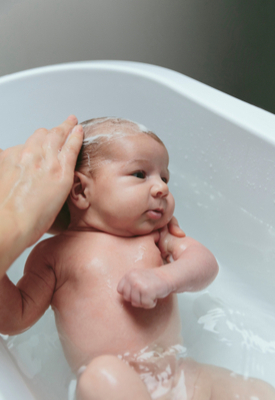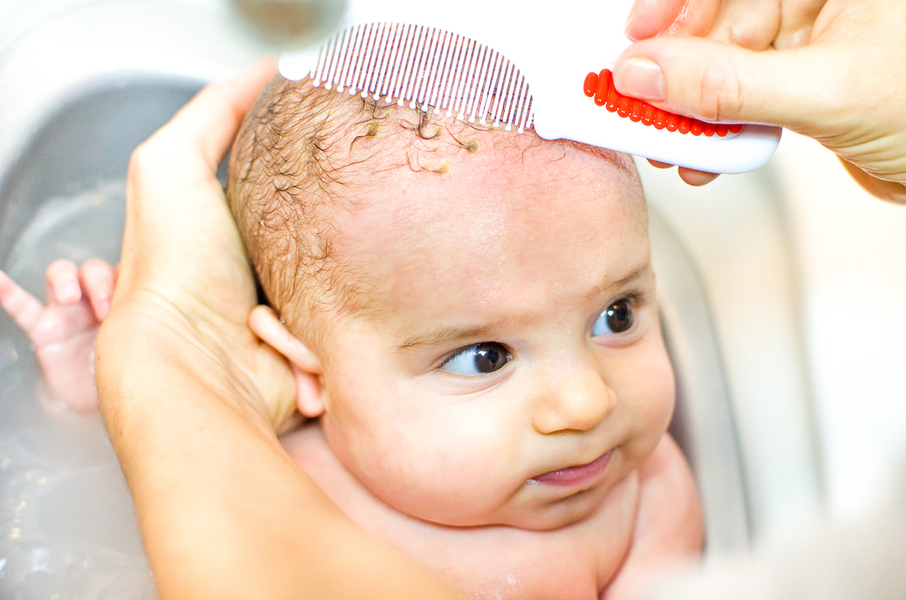Cradle cap is a rash that can develop on a baby’s scalp, usually between the ages of one-three months of age. The name “cradle cap” comes from the fact that it happens to very young babies, hence “cradle.” But also “cap” because cradle cap can look like a thick and waxy, sometimes yellow layer that covers the skin of the scalp like a cap. Cradle cap is not dangerous and it is not a sign that you’re doing something wrong. It is easy to get rid of cradle cap in a gentle, natural way.
Like the adult version of cradle cap that we know as “dandruff,” cradle cap is caused by seborrheic dermatitis. And like dandruff, cradle cap is unattractive. It can be embarrassing to show off your baby when he or she has cradle cap. Especially when well-meaning friends and relatives tell you, “My baby never had that,” or offer unwanted advice on how to cure the condition.
The experts are divided on what causes cradle cap. Some doctors believe that it comes from overactive oil glands due to excess hormones the baby gets from the mother during pregnancy and nursing. Others believe that cradle cap may be the result of an overgrowth of yeast named Malassezia that likes to feed on the stuff called sebum that comes out of oil glands. Both theories have to do with oil glands and both make a lot of sense. Cradle cap can be found not just on the scalp, but anywhere on the body where there are many oil glands, including the face, chest, and back.
Cradle Cap Isn’t Itchy
Cradle cap should not be confused with eczema. Eczema is uncomfortable for baby, and itchy. Cradle cap, on the other hand, doesn’t seem to bother baby at all. It just doesn’t look very pretty.

You don’t really have to do anything about cradle cap. It usually goes away by itself, with regular shampooing with a gentle shampoo made just for baby. Expect it to take 2 weeks to 3 months for cradle cap to disappear on its own. For some babies, the condition lasts for one year or for as long as up to four years. But such cases are uncommon.
Some moms prefer to be more proactive and do what they can to remove the “cap.” It’s not difficult to treat and it can feel really nice to restore your baby’s scalp to its normal condition and appearance.
Cradle Cap Treatment
Here’s what you need to do to get rid of cradle cap:
- Shampoo with baby shampoo and dry baby’s hair gently, with a soft towel
- Apply a few drops of baby oil or mineral oil to the baby’s scalp
- Gently massage the oil into the cap
- Wait 30-60 minutes to allow the oil to soften the cradle cap
- Comb the scales out of baby’s hair with a baby comb
- Keep tissues handy to wipe the scales off the comb as you go
- If the baby’s scalp begins to redden, stop, and repeat the treatment a day or two later
Note that olive oil should not be used to treat cradle cap. It is believed that olive oil can strip the skin’s natural moisture barrier. This can make things worse. If you prefer to use a natural oil, use coconut or almond oil to get rid of cradle cap. These are gentle oils that will add moisture to your baby’s thirsty skin.
Sometimes, cradle cap comes with reddened skin and more than just the scalp is involved. The child may seem ill or have a fever. In this case, it’s time to check with your baby’s doctor. A case of cradle cap that gets this complicated or hangs around for too long, needs to be checked out by a medical professional. In severe cases, doctors may prescribe antifungal shampoo, or anti-inflammatory plus anti-yeast cream or oil to help control the condition.
Cradle cap shouldn’t be oozing or bleeding, or causing lots of discomfort or itching. There should be no swelling. These may be signs of eczema or even infection. See your doctor. In the rare case of infection, baby may need some oral antibiotics to clear things up.
Found what you just read useful? Why not consider sending a donation to our Kars4Kids youth and educational programs. Or help us just by sharing!
